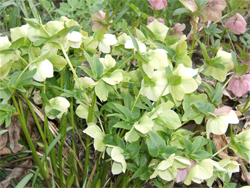Before we consider my top five materials, a quick note. I have not included water as a separate item in my list. This is because it is a big subject, and because using water effectively can be expensive. However, though the infrastructure required to support them can be costly, water pumps have obvious play and educational merit, and are usually very popular with children.
So, water aside, here are my top five natural materials, and how to use them.
Sand
Sand is a versatile material with great appeal to children. First, forget the principle of less is more. More is more: the larger the sand area the more it can be used in play and learning. Aim to create a beach-like sand area, ideally with water alongside it. Vary resources in the sand pit (shells, stones, pebbles) and tools (moulds, spades, buckets) but also have times when the sand is uncluttered so that children can interact with it directly and simply.
Maintenance is minimal, but the sand will need to be replenished over time, and it does have a tendency to creep into areas where it is unwanted! The sand area will require a breathable, lightweight, easily-movable cover.
Be sure to buy play sand that it is non-toxic, non-staining and safe if inhaled. It is also essential that children’s play be supervised at all times - whatever materials they are using.
Soil
Schools tend to reserve soil for flower beds and not for use as a play material. But its properties make it ideal for play. Children can dig in it, turn it over, bury and find treasures, make holes, fill vessels, research mini-beasts, etc. When dry it is hard and crumbly, but when moist it can moulded. Wet, it becomes mud: a material particularly fascinating to children, who can use it to make imprints, marks and noises, and generally squish and squelch around.
A soil space should, where possible, be large enough for children to dig in using long handled tools, thereby learning to use their entire bodies to manipulate the soil. At the end of a session, children can be given brooms and brushes and encouraged to tidy up by restoring the soil to its designated area.
With soil, hygiene is particularly important. When not in use, the area should be covered by a tarpaulin to prevent dogs and cats from using it. Ensure that, before children enter the soil area, any cuts are covered with plasters or gloves to prevent infection.
Boulders
Boulders are becoming popular features for playgrounds. It is easy to see why. They enhance the landscape, provide great opportunities for balancing and jumping, and are perfect for weary staff and children looking for a seat!
Combined with sand, boulders can create the perfect setting for adventures. Ensure that you only use boulders that are safe and suitable for children’s play.
Wood
Bark and wood chippings make an excellent safety surface. Wood is tactile and pleasant to touch; it blends in with the natural environment and is strong, durable and versatile.
Wooden trunks or beams can be balanced on. Trees with low lying branches are great for climbing or for creating dens. Slices of trunk make brilliant stepping stones that children can move around.
Planted wooden rounds are great for manoeuvring along, helping children to develop balance and coordination and to overcome challenges by helping one another. Best of all, wood is relatively cheap. Ask your local council’s parks department, your local Wildlife Trust and your local sawmills if they’ll donate any materials, such as trunk slices or other suitable off-cuts.
Be sure regularly to check any pieces for splinters or sharp edges, and sand down anything which might jeopardise safety.
Plants
It wouldn’t be a play garden without plants. As well as creating a more pleasant environment, plants offer further benefits. Herbs, for example, are perfect for sensory development and can be used in home economics lessons. Flowers and petals are very appealing and can be used to create patterns, potions and broths. Latin could even be introduced in the form of spells and incantations associated with such creations - though it is of course essential that children do not eat or drink anything they shouldn’t!
Make the most of weeds, dandelions, daisies and buttercups alongside other plants. It could be that you have a green-fingered member of staff or member of the school community who might be willing to maintain a school garden as a separate project.
It is hard to highlight just five features of nature, but I hope this overview helps to inspire you to create the best possible play areas for your school. Budgets are always limiting, but creative thinking can help keep spending down.


















